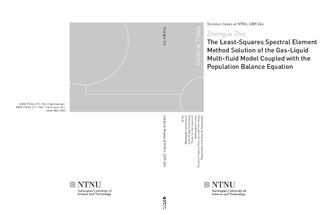| dc.contributor.author | Zhu, Zhengjie | nb_NO |
| dc.date.accessioned | 2014-12-19T13:23:10Z | |
| dc.date.available | 2014-12-19T13:23:10Z | |
| dc.date.created | 2010-02-18 | nb_NO |
| dc.date.issued | 2009 | nb_NO |
| dc.identifier | 297012 | nb_NO |
| dc.identifier.isbn | 978-82-471-1944-0 (printed ver.) | nb_NO |
| dc.identifier.isbn | 978-82-471-1945-7 (electronic ver.) | nb_NO |
| dc.identifier.uri | http://hdl.handle.net/11250/248161 | |
| dc.description.abstract | This thesis work concentrates on the modelling of dispersed bubbly flow encountered widely in the chemical, oil & gas and nuclear industries. The computational fluid dynamics (CFD) that provides detailed information of gas-liquid flow has many advantages over the traditional modelling, which results in an enormously increased use of the CFD in the last decades.
It has been found out that in order to describe the complex inhomogeneous behaviour of the gas-liquid flow caused by the size differences of bubbles, the necessary set of model equations to be solved must consist of the multi-fluid model for the flow, and a population balance equation (PBE) describing the bubble size distributions.
Such a complex model leads to a very expensive computational load and thus requires an advanced, accurate and efficient method to enable an appropriate numerical solution. The least-squares spectral element method (LSSEM) which possesses many extraordinary numerical properties may be a very attractive method to deal with such a model.
When solving the multi-fluid model the LSSEM has the potential of being much more accurate than the finite volume method (FVM) due to its higher order approximation. The pressure-velocity iterative algorithms like the semi-implicit pressure linked equation (SIMPLE) and the interphase slip algorithm (IPSA), are not required by the LSSEM. Furthermore, the properties of this method excludes the necessity of upwinded discretization of the convective terms.
Being a PBE solver, the Gauss-Legendre-Lobatto (GLL) quadrature points used in the LSSEM ensures a more efficient discretization of the internal coordinate than the method of classes (CM). Unlike the Method Of Moments (MOM), the LSSEM provides a direct estimation of the number density function. The moments of any order can be retrieved by post-calculation, and the number of desired moments does not affect the number of transport equations to be solved. The least-squares formulation leads to a better conditioned system than the Quadrature Method Of Moments (QMOM), and it does not pose any stability problem.
A new iterative algorithm is presented when using the LSSEM to couple the multi-fluid model and the PBE. It is based on the overall residue minimization so that the flow and the PBE are solved within same framework. The LSSEM also fully exploits the idea of single or multi-velocity group previously proposed in the homogeneous/inhomogeneous MUltiple-SIze-Group (MUSIG) models. The h/p-refinement divides the internal coordinate with high flexibility regarding to the size and velocity segregations.
For many commonly used breakup kernels in physical problems, the conservation of volume/ mass is not always fulfilled, once they are employed in the CFD models. This unphysical feature is highly undesirable. In this work, the author propose a least-squares spectral element method which allows for incorporating the disperse phase mass-conservation (in the form of a continuity equation for the disperse phase) by means of the Lagrange multipliers method. The PBE is solved under this additional constraint by finding the saddle point of the coupled system. The results obtained by the constrained LSM show that the mass is conserved everywhere in the domain with high accuracy. The constrained LSM has significantly improved the performance of the nonconservative breakup kernels.
A generic LSSEM toolbox lssem-suite has been designed and developed by the author. The lssem-suite toolbox is very flexible so that users can easily define the problem operator and other informations needed.
The first bubble column model consisting of both flow equations and the PBE has been successfully solved by the LSSEM with the use of the lssem-suite. Interphase forces and breakage/coalescence kernels have been taken from the literature. The algorithm, coupling scheme as well as implementation are illustrated in the thesis. The resulting solution has been validated against experimental data obtained for two-phase flow in a bubble column. The predicted bubble size distribution and other flow quantities are in good agreement with the experimental data. | nb_NO |
| dc.language | eng | nb_NO |
| dc.publisher | Norges teknisk-naturvitenskapelige universitet, Fakultet for naturvitenskap og teknologi, Institutt for kjemisk prosessteknologi | nb_NO |
| dc.relation.ispartofseries | Doktoravhandlinger ved NTNU, 1503-8181; 2009:264 | nb_NO |
| dc.relation.haspart | Zhu, Zhengjie; Dorao, C.A.; Jakobsen, H.A.. Solution of bubble number density with breakage and coalescence in a bubble column by Least-Squares Method. Progress in Computational Fluid Dynamics, An International Journal. (ISSN 1468-4349). 9(6/7): 436-446, 2009. <a href='http://dx.doi.org/10.1504/PCFD.2009.027375'>10.1504/PCFD.2009.027375</a>. | nb_NO |
| dc.relation.haspart | Zhu, Zhengjie; Dorao, C.A.; Jakobsen., H.A.. On the Coupled Solution of a Combined Population Balance Model Using the Least-Squares Spectral Element Method. . 48(17): 7994-8006, 2009. <a href='http://dx.doi.org/10.1021/ie900088q'>10.1021/ie900088q</a>. | nb_NO |
| dc.title | The Least-Squares Spectral Element Method Solution of the Gas-Liquid Multi-fluid Model Coupled with the Population Balance Equation | nb_NO |
| dc.type | Doctoral thesis | nb_NO |
| dc.contributor.department | Norges teknisk-naturvitenskapelige universitet, Fakultet for naturvitenskap og teknologi, Institutt for kjemisk prosessteknologi | nb_NO |
| dc.description.degree | PhD i kjemisk prosessteknologi | nb_NO |
| dc.description.degree | PhD in Chemical Process Engineering | en_GB |

